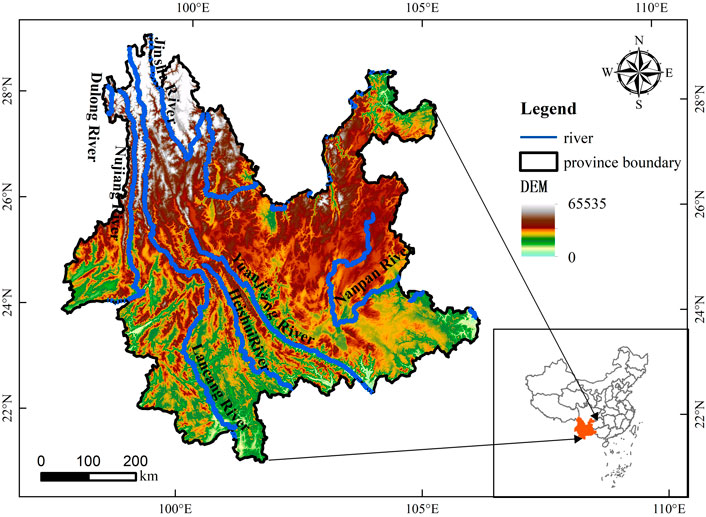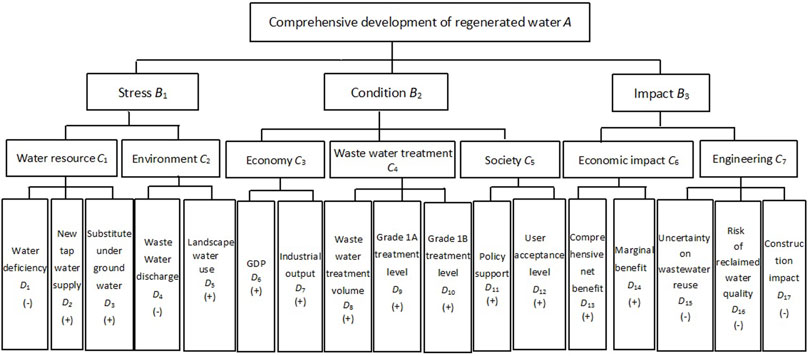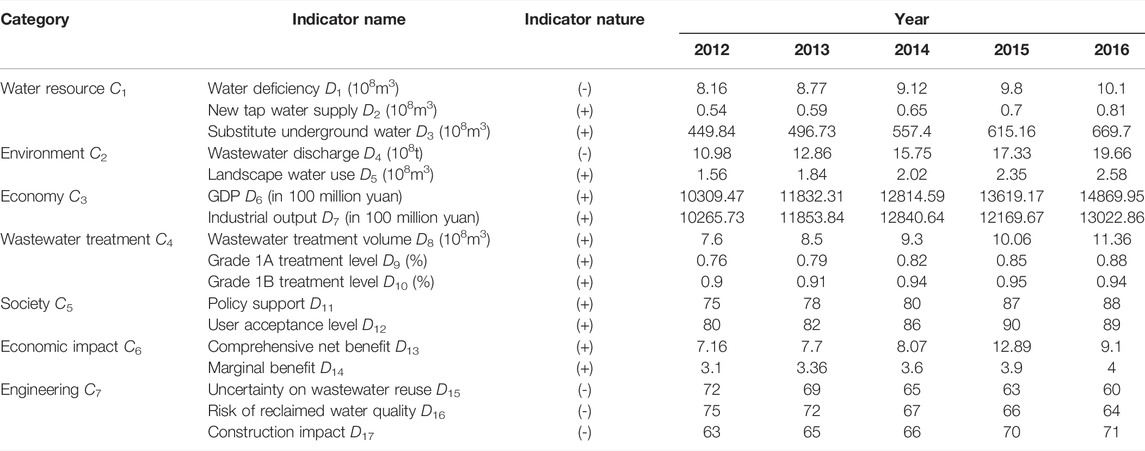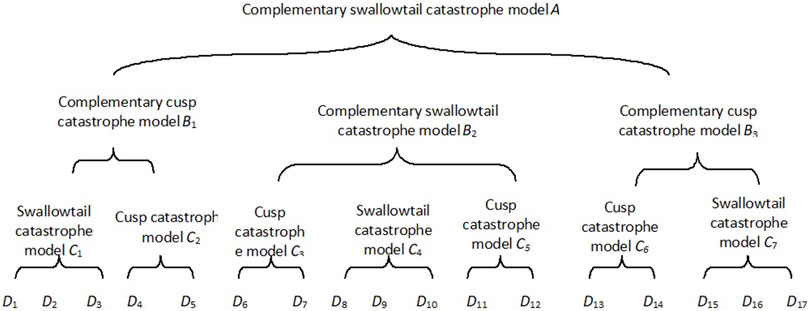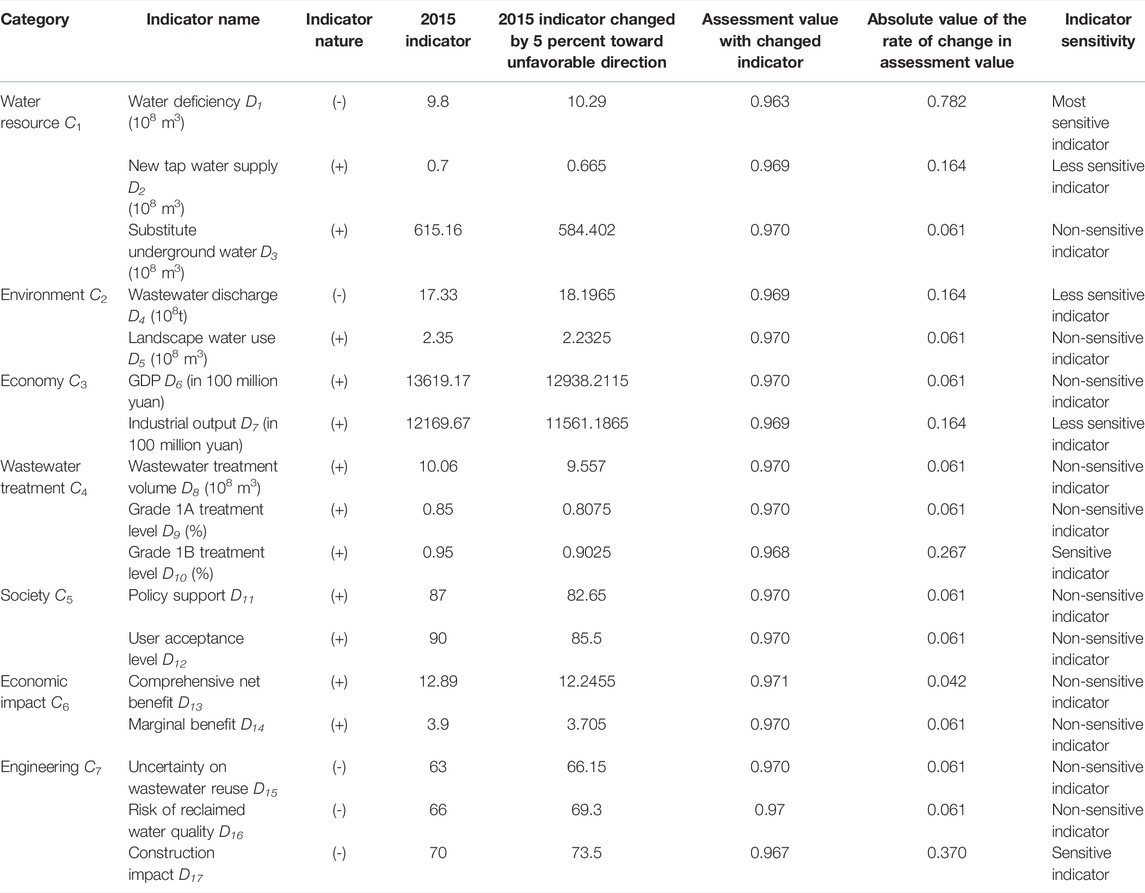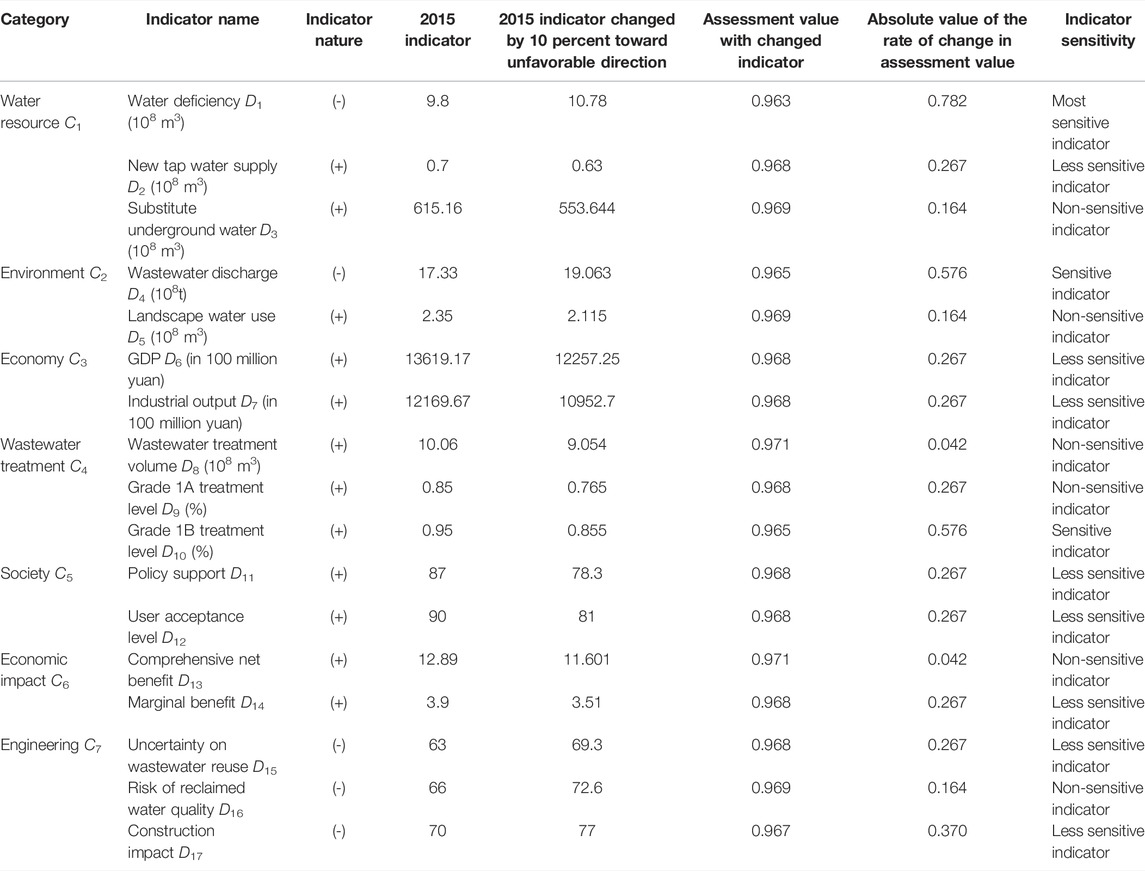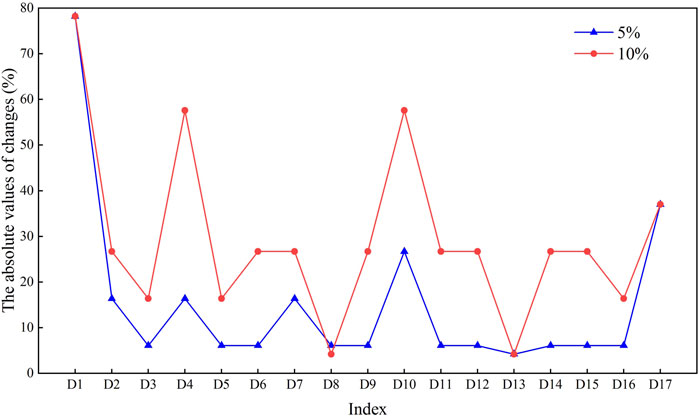- School of Water Resources, North China University of Water Resources and Electric Power, Zhengzhou, China
In order to utilize reclaimed water resources reasonably and efficiently, it is necessary to strengthen the evaluation of reclaimed water. However, a major problem with traditional reclaimed water assessment methods is that it mostly focuses on a single aspect. In this study, an evaluation model of comprehensive development level of reclaimed water which consists of four layers with three criteria and 17 indicators is established. An improved catastrophe theory was utilized to obtain diversely distributed adjusted assessment values of comprehensive development level of reclaimed water. Finally, the single-factor sensitivity analysis was performed on the aforementioned model, and the sensitivity sequence of each indicator was determined according to the comprehensive development ability of reclaimed water. The results showed that 1. In Yunnan Province, the comprehensive development level of reclaimed water grew steadily from 2012 to 2015 but declined in 2016. Water deficiency was the most sensitive factor, followed by wastewater discharge, grade 1B treatment level, and construction impact as the secondary sensitive factors. 2. Compared with the fuzzy comprehensive evaluation method, the improved catastrophe evaluation method has the advantages of the rigorous theory, concise model, and simple calculation, and the decision result is more objective and reliable.
1 Introduction
As a non-conventional water resource, reclaimed water is obtained by the proper treatment of wastewater in accordance with nominated water quality standards, which can be used for designated purposes (Wu et al., 2018; Paul et al., 2020). It plays an important role in alleviating water shortages and water environmental pollution (Garcia and Pargament, 2015; Ofranko et al., 2020). Therefore, utilization of reclaimed water is an urgent task to mitigate global water shortage (Nguyen et al., 2017).
Reclaimed water assessment needs to be strengthened for reasonable and efficient use of reclaimed water (Wang et al., 2017; Maestre-Valero et al., 2019). Traditional reclaimed water assessment methods often focus on a single aspect (Furumai, 2008; Glick et al., 2019). For example, Yu et al. (2020) used chemometrics and multivariate statistics to evaluate the quality of reclaimed water from Chaobai River in Beijing; Bailey et al. (2020) developed a quantitative microbial risk assessment of reclaimed water to assess the additional disease burden from wastewater reuse; Li et al. (2016) assessed the value of reclaimed water resource in Xi’an, Xianyang, Baoji, and Weinan based on the fuzzy matter element model; Listowski et al. (2013) established an economic evaluation model applying for any infrastructure system of urban recycled water. However, each of these assessments focuses on the unilateral evaluation of benefits, risks, and water quality, and these index systems can only reflect the characteristics of a certain aspect in the process of reclaimed water utilization (Wang et al., 2012). The index system is single, which is unilateral and one-sided, without evaluating the whole process of comprehensive reclaimed water utilization. In order to comprehensively evaluate the comprehensive development level of reclaimed water in different regions, it is necessary to establish a comprehensive evaluation index system covering more factors.
At present, the fuzzy comprehensive evaluation method is a commonly used comprehensive evaluation method. Zhang et al. (2021) used fuzzy comprehensive evaluation to assess the stability of ground surface along tunnels in karst terrain. Li et al. (2018) used fuzzy comprehensive evaluation to evaluate the comprehensive development level of reclaimed water in Luoyang city. Zhang (2021) combined the analytic hierarchy process and the fuzzy comprehensive evaluation method to obtain the road bridge construction safety risk level.
The catastrophe theory (Tang et al., 2009; Arouq et al., 2020) was systematically described by Rene Thom, a French mathematician, in the book Structural Stability and Morphogenesis (Li et al., 2019; Maestre-Valero et al., 2019) published in 1972, which laid a foundation for the research of the catastrophe theory. At present, the catastrophe theory has been applied to many disciplines. For example, Cubitt and Shaw (1977) analyzed the deposition process of materials with the catastrophe theory; Potier-Ferry (1985) described the instability phenomenon in elastic fracture mechanics and plastic mechanics with the catastrophe theory. Th ecatastrophe theory has also been widely used in the evaluation of water resources. Ahmed et al. (2015) proposed catastrophe theory-based evaluation to evaluate groundwater potential areas in arid areas; Shao et al. (2012) adopted the catastrophe evaluation method to evaluate agricultural water utilization efficiency.
In this study, the improved catastrophe method is used to evaluate the comprehensive development level of reclaimed water, and the fuzzy comprehensive evaluation method is used to check the results.
In addition, there are a number of factors that influence the comprehensive development level of reclaimed water. These factors are characterized by uncertainty and randomization in the assessment process, which will further affect assessment results (Zhao et al., 2015). However, analyzing the uncertainty of the factors of comprehensive development ability of reclaimed water and determining the importance sequence of these factors are of great significance for controlling the comprehensive development level of reclaimed water which act as a reference for the planning of reclaimed water development.
Therefore, in order to make reasonable and efficient use of reclaimed water resources, the assessment of the comprehensive development level of reclaimed water should be improved as an aid to help fully assess the level of reclaimed water and find key factors that increase the development level of reclaimed water.
2 Materials and Methods
Study Area
Yunnan Province lies on the border of southwest China, Figure 1, with a total area of 394,100 square kilometers, accounting for 4.1% of the country’s total land area, ranking eighth in China. Yunnan Province is rich in water resources. In 2014, the total amount of water resources in the province was 172.7 billion cubic meters, ranking the third in China. It has more than 900 rivers and more than 40 natural lakes each of whose catchment area is over 100 square kilometers. The per capita water resource in Yunnan is 1.83 times of that in China (2014 water resources bulletin of Yunnan Province). In spite of that, water resources in Yunnan Province are distributed unevenly in terms of time and space, from May to October, the precipitation is large, reaching more than 80% of the annual precipitation, while from November to April, the precipitation is less than 20% of the annual precipitation, Yunnan is inflicted with severe seasonal water shortage. In addition, Yunnan Province belongs to mountainous and plateau terrain, with a mountainous area of 331,100 square kilometers, accounting for 84% of the total area of the province, and various types of karst landforms are developed. The population, cultivated land, and water resources do not match. The dam area, which accounts for less than 7% of the land area of the province, concentrates about one-third of the population and two-thirds of the cultivated land, but the amount of water resources is only 5% of the province, the development and use of water resource impose a great difficulty and require a high cost; as a result, the available water resource is quite limited. In this context, it is of great urgency to study the comprehensive development level of reclaimed water in Yunnan Province.
Catastrophe Theory
The catastrophe theory can be adopted to directly address discontinuity independent of any special internal mechanism, in particular to systems whose internal forces are yet to be determined (Ather, 2021). The theoretical mathematical model is simple, and can solve the unknown problems that cannot be solved by traditional mathematical methods, so it is widely used in many fields. Common catastrophe models are described in Table 1.
The criterion for selecting different catastrophe models given in Table 1 is the number of control variables. When the control variable is 1, it corresponds to the fold catastrophe. When the number of control variables is 2, it corresponds to the cusp catastrophe. When the number of control variables is 3, it corresponds to the swallowtail catastrophe. When the number of control variables is 4, it corresponds to the butterfly catastrophe. The control variables here are the evaluation indexes of each layer.
Catastrophe Theory-Based Multi-Criterion Assessment Method
The catastrophe theory-based assessment method (Zhang et al., 2013; Lv et al., 2020) is a multi-criterion approach and includes the following steps:
1) Development of an assessment matrix system. Indicators are selected according to the internal mechanism of the system to develop a multi-layer tree structure matrix which is able to reflect the importance sequence of these indicators.
2) Normalization of dimension of bottom layer data (control variables). In this step, original data of all indicators are normalized to non-dimensional comparable data within 0∼1.
For indicators concerning which higher values are preferred:
For indicators concerning which lower values are preferred:
3) Normalization. A normalization formula is used to perform recurrence qualification analysis-based calculation to obtain the initial comprehensive assessment value Ri. According to the order from the bottom to the top, different potential functions of catastrophe model are selected according to the number of control variables (indicators), and the recursive calculation is carried out layer by layer. Finally, the catastrophe assessment value Ri can be obtained. Given the nature of the practical problem, “complementary” or “non-complementary” criterion applies. ① Non-complementary criterion: when the effects of control variables on the state variables are not interchangeable, the final value of these control variables is determined according to minimal principle; ②complementary criterion: when the effects of control variables on the state variables can compensate each other, the final value is the mean of these control variables.
Improvement of the Catastrophe Assessment Method
Given the fact that normalization formulas for catastrophe assessment methods feature with convergence results, the final assessment results are often high (approach to 1, in Table 4), and the gaps between assessment values are often small. Although the quality of the evaluation object can be determined by the size order of the comprehensive evaluation value, it is not as intuitive as the evaluation value obtained by other comprehensive evaluation methods. 1. The year with relatively low comprehensive development level (2013) has a very high comprehensive evaluation value (
In particular, an adjusted initial catastrophe assessment was used to overcome the aforementioned problem and improve the catastrophe assessment method in this study. The adjustment process is described as follows:
1) The grade scale is refined to calculate the top-layer catastrophe assessment value rn when each bottom layer control variable is 0, 0.05, 0.1, 0.15, 0.2,..., 0.9, 0.95, 1. In addition, this scale is used for describing the initial comprehensive value. Each grade corresponds to the following range (rn,rn+1) (n = 0, 1, 2, 3,..., 19).
2) After the initial comprehensive assessment value Ri is obtained through the recurrence calculation is 2.2, given the grade scale (rn,rn+1) (n = 0, 1, 2, 3,..., 19) to which Ri corresponds.
3) Ri is then mapped to the corresponding evenly distributed range, and obtains the calculation formula of the adjusted assessment value R′i, which therefore increases the definition of the comprehensive assessment value.
4) The adjusted comprehensive value is taken as the basis of the comprehensive evaluation value. The larger the adjusted comprehensive value is, the better the scheme is.
A Sensitivity Analysis of Factors that Influence the Comprehensive Development Level of Reclaimed
The sensitivity analysis is a crucial approach to analyze uncertain factors in an assessment (Schneeweiss, 2010). In this analysis, correlation to the assessment result is analyzed and predicted by changing each factor within its possible value range. A sensitivity analysis can be based on a single factor or multiple factors.
In a single-factor sensitivity analysis, only one factor is changed to an unfavorable direction (positive indicator is decreased by a certain percent and negative indicator is increased by a certain percent) while other factors remain unchanged; which is used to study the impact of change in such factors on the assessment result. A factor which shows a great impact on the output value is called a sensitive factor, otherwise, a non-sensitive factor. Given the fact that a change in a sensitive factor may impose a great impact on the development level of reclaimed water, all sensitive factors must be strictly controlled.
Results and Discussion
Assessment Matrix System
The Basis of Index Selection Permission to Reuse and Copyright
The system for assessing the comprehensive development level of reclaimed water consists of many indicators and various influencing indicators interact with each other, which makes it a challenge to construct the assessment matrix system.
1) Comprehensive consideration of water quantity, water quality, technology, society, benefit, risk and other factors in combination with the actual situation.
2) Referring to relevant research results, using the literature survey method to determine indicators from the use frequency of indicators and quantitative difficulty of indicators.
Construction of the Assessment Matrix System
This matrix system (Figure 2) consists of four layers: target layer (A), criterion layer (B), element layer (C), and indicator layer (D). Based on the three assessing criteria: stress index, condition index, and impact index, the basic framework is constructed, covering a total of 17 indicators, the indicators of each layer are arranged from left to right according to the decreasing degree of their influence on the higher layer, which is basically enough to reflect the comprehensive development level of reclaimed water.
The stress index reflects the demand degree of the development and utilization of reclaimed water at the present stage. The condition index describes the economic, technical, and social conditions of the development and utilization of reclaimed water at the present stage. The impact index describes the economic benefits and potential risks brought by the development and utilization of recycled water to the whole society.
The meanings of some indicators are as follows: water deficiency D1 refers to the social water demand that cannot be met under the existing water supply level. The newly added tap water supply D2 refers to the amount of tap water supply that can be increased by the development and utilization of reclaimed water. D3 refers to the increase of groundwater supply to solve the problem of insufficient water supply. The discharge standard of pollutants for the municipal wastewater treatment plant (National Standards of People’s Republic of China GB 18918-2002) is formulated mainly based on the treatment process and the function of the discharged receiving water body. According to the environmental functions and protection objectives of municipal wastewater treatment plants discharged into surface waters and the treatment process of wastewater treatment plants, the standard values of conventional pollutants of basic control items are rated into first-level standards, second-level standards, and third-level standards. The first-level standard is divided into standard A and standard B. The standard A of the first-level standard is the basic requirement for the effluent from the municipal wastewater treatment plant as reuse water. When the effluent from the wastewater treatment plant is introduced into the river or lake with less dilution capacity as municipal landscape water and common reuse water, standard A of the first-level standard shall be implemented. When the effluent from the municipal wastewater treatment plant is discharged into the type III functional waters of GB3838 surface water (except for the designated drinking water source protection areas and swimming areas), GB3097 seawater type II functional waters and closed or semi-closed waters such as lakes and reservoirs, standard B of the first-level standard shall be implemented. The grade 1 A and B treatment levels D9 and D10 refer to the degree to which the reclaimed water resources in the region meet the standard A (B)%. The comprehensive net benefit of the system D13 refers to the system benefit that can be obtained after the operation of the reclaimed water project. The uncertainty on wastewater reuse D15 refers to the risk and uncertainty of existing wastewater reuse projects in operation. The risk of reclaimed water quality D16 refers to the potential risk of reclaimed water quality after treatment. Construction impact D17 refers to the negative impact of the implementation of the reclaimed water project on the surrounding environment. Among the indexes, D2, D3, D5, D6, D7, D8, D9, D10, D11, D12, D13, and D14 are positive indexes. The larger the index is, the better it is. That is to say, the larger the index is, the higher the comprehensive development level of reclaimed water is; D1, D4, D15, D16, and D17 are negative indicators. The smaller the indicator is, the better it is. That is to say, the smaller the indicator is, the lower the comprehensive development level of reclaimed water is. The original data are standardized according to formula (2). D11–D12 and D15–D17 are qualitative indexes, and the others are quantitative indexes. The qualitative indicators (D11–D12, D15–D17) selected in this study are processed quantitatively by means of expert scoring or a questionnaire survey, so as to avoid the subjectivity of data acquisition. Among them, policy support D11, uncertainty on wastewater reuse D15, the risk of reclaimed water quality D16, and construction impact D17 are obtained by the method of scoring by experts; the user acceptance level D12 is obtained by the questionnaire survey. The target groups of the questionnaire include different genders, ages, occupations, and income groups. The number of respondents is 200. The questionnaire includes three types of questions such as the social background of the interviewees, understanding of water resources, and habits of water use and the acceptance of reclaimed water. The aforementioned indicators adopt a centesimal system.
Standardization of Basic Data
2012–2016 comprehensive development level of reclaimed water in Yunnan Province is the subject of this study. Quantitative data for this study were obtained from Yunnan Water Resource Reports, Yunnan Provincial Statistical Year Books and other source, and qualitative data were obtained by questionnaires and other methods, as shown in Table 2.
The “Indicator nature” means whether an indicator is positive or negative. An indicator is positive if it is “+” (D2、D3、D5、D6、D7、D8、D9、D10、D11、D12、D13、D14), and negative if it is “-” (D1、D4、D15、D16、D17).
Calculation of Assessment Values With Improved Catastrophe Models
In indicator layer (D): indicators D1∼D3, D8∼D9, and D15∼D17 form a complementary swallowtail catastrophe model, and indicators D4∼D5, D6∼D7, D11∼D12, and D13∼D14 a complementary cusp catastrophe model; in element layer (C): C1∼C2 and C6∼C7 form a complementary cusp catastrophe model, and C3∼C5 a complementary swallowtail catastrophe model; in criterion layer: B1∼B3 form a complementary swallowtail catastrophe model. Layer-by-layer calculations according to the normalization formulas shown in Table 1 are depicted in Figure 3 and result in initial assessment values.
The grade scale is refined to calculate the target layer assessment threshold value rn when the membership of each indicator in the bottom layer is (0, 0.05, 0.1, 0.15, 0.2,..., 0.9, 0.95, 1). Also, this scale is used for describing the initial comprehensive value. This process is shown in Table 3. If the calculated initial assessment value Ri falls within (rn,rn+1) (n = 0, 1, 2, 3,..., 19), the comprehensive development level of reclaimed water is considered as grade n+1.
The initial assessment value Ri is transformed to the adjusted comprehensive assessment value R′i according to formula (3), that is, the adjusted comprehensive assessment value obtained with the improved catastrophe method, as shown in Table 4.

TABLE 4. Comprehensive development level of reclaimed water calculated with the improved catastrophe assessment method.
It can be seen from Table 4 that the conclusions of catastrophe evaluation method are aggregated, the evaluation results tend to 1, and the differences between the evaluation values are small (0.941, 0.960, 0.971, and 0.955), which is not conducive to people’s intuitive judgment; the improved catastrophe evaluation method overcomes the problem that the comprehensive evaluation value of traditional catastrophe evaluation method is too high and too close, and the results are scattered, so it is easy to draw conclusions and more convincing.
Quantification of Threshold Values Corresponding to Comprehensive Development Levels of Reclaimed Water
In everyday life, standards for assessing matters are customary. For example, people tend to use fuzzy words like “outstanding, good, acceptable, pass, and fail” as the assessment scales. However, in the aforesaid improved assessment, 20 scales are used in order to ensure a higher precision, which is inconsistent with people’s habit and presents a challenge for obtaining assessment conclusion.
To more intuitively assess the development of reclaimed water, the grade scales are further restricted to five scales by having the membership degrees of indicators evenly distributed, that is, (0, 0.2), (0.2, 0.4), (0.4, 0.6), (0.6, 0.8), and (0.8,1] and by dividing the target layer into five corresponding ranges, as shown in Table 5.

TABLE 5. Standards for grade classification in relation to comprehensive development level of reclaimed water.
It is known from calculation results with the improved evaluation method (Table 4) that R′2012 = 0.031 means that the comprehensive development level of reclaimed water in 2012 is “poor” (grade I); R′2013 = 0.334 means that the 2013 level is “pass” (grade II); R′ value from 2014 to 2016 falls within (0.4, 0.6), indicating the 2014–2016 level is “acceptable” (grade III), as shown in Table 6.
Discussion
In order to analyze the reliability of the catastrophe theory evaluation results, the fuzzy comprehensive evaluation method (Zhang et al., 2021; Li et al., 2018; Zhang et al., 2021) is applied to the comprehensive development capacity evaluation of reclaimed water. The index selection is the same as the catastrophe evaluation method, and the weight is determined by the combination weighting method of AHP (analytic hierarchy process) and entropy weight. The results are shown in Table 7.
It can be seen from Table 7 that the evaluation results of the two methods are basically the same, and the evaluation value of the fuzzy comprehensive evaluation method is slightly higher than that of the improved catastrophe evaluation method as a whole. Although the result of the fuzzy comprehensive evaluation method in 2012 is one level higher than that of the improved catastrophe evaluation method, its comprehensive evaluation value is 0.208, which is close to the threshold value of these two levels (0.2). The results of the two evaluation methods are consistent in other years, and the ranking of evaluation values in each year is also consistent. The fuzzy comprehensive evaluation method does not need to determine the index weight artificially, which reduces the difficulty of evaluation and is more worthy of popularization and application.
From the perspective of trend, the comprehensive development level of reclaimed water grew steadily from 2012 to 2015, although there was a certain degree of decline in 2016, it still showed an upward trend over the years. This is mainly because during the “12th Five Year Plan” period, Yunnan Province invested about 1.8 billion yuan to build 98 (centralized) reclaimed water utilization facilities, added 230,800 tons/day of reclaimed water treatment scale, and build 1,496 km of reclaimed water pipe network to ensure that the recycling rate of urban sewage in the province reaches 15%. Therefore, from 2012 to 2015, the comprehensive development level of reclaimed water showed an upward trend year by year. According to the water resources bulletin of Yunnan Province, in 2016, the amount of surface water resources in Yunnan Province was 5.5% less than the multi-year average, and the amount of groundwater resources was 9.3% less than the multi-year average, resulting in the decline of the comprehensive development capacity of reclaimed water in 2016.
Sensitivity Analysis of Factors That Influence Comprehensive Development Level of Reclaimed Water
According to the evaluation results, the comprehensive development level of reclaimed water was low in 2012 and showed an upward trend from 2012 to 2016. After 2014, the comprehensive development level of reclaimed water tended to be stable. In this study, taking the comprehensive development level of reclaimed water in Yunnan Province in 2015 as the research object, and based on the evaluation model of comprehensive development level of reclaimed water established before, single-factor sensitivity analysis of the model indicators was conducted to study how the assessment value changes when each indicator is changed toward the unfavorable direction by the same percent (5% (Table 8), 10% (Table 9)) and determine the sensitivity of each indicator according to the absolute value of so-caused change in assessment value.
The absolute values of changes in assessment values calculated by changing each of the 17 indicators toward the unfavorable direction according to Table 8 and Table 9 are plotted in Figure 4.When the indicators change 5% toward the unfavorable direction, water deficiency (D1) is the most sensitive factor and grade 1B treatment level (D10) and construction impact (D17) are sensitive factors; when the indicators change 10% toward the unfavorable direction, water deficiency (D1) is the most sensitive factor and wastewater discharge (D4) and grade 1B treatment level (D10) are sensitive factors. Therefore, water deficiency (D1) is the controlling factor in the assessment of comprehensive development level of reclaimed water, which should be given key monitoring. Wastewater discharge (D4), grade 1B treatment level (D10), and construction impact (D17) are important factors. When these factors change, they will also have a great influence on the comprehensive development level of reclaimed water, which should be strictly controlled.
The results show that water deficiency (D1) is the most sensitive factor; and wastewater discharge (D4), grade 1B treatment level (D10), and construction impact (D17) are sensitive factors.
Water deficiency (D1) and wastewater discharge (D4) reflect the demand for reclaimed water in terms of water resources and water environment, that is, the pressure on the development and utilization of reclaimed water. They are the decisive indicators affecting the comprehensive development level of reclaimed water. Grade 1B treatment level (D10) is the water quality treatment standard that the sewage treatment plant can meet. It is the technical condition for the development and utilization of reclaimed water at this stage, which determines the process, cost, and the uses of reclaimed water. Therefore, the grade 1B treatment level (D10) is a key indicator affecting the comprehensive development level of reclaimed water. In addition, with people’s increasing attention to environmental problems, the implementation of reclaimed water project will inevitably have a certain impact on the surrounding environment. Therefore, the construction impact (D17) has also become an important indicator affecting the comprehensive development level of reclaimed water. On the premise of finding out the situation of local water resources, local governments should formulate reclaimed water use planning, adopt reasonable water quality treatment standards, further improve the sewage treatment capacity, and give full play to the advantages of reclaimed water use in the construction and operation cost of water supply system, so as to bring significant environmental benefits and promote the construction of a water-saving society.
These factors should be given key monitoring and strictly controlled because any change in them may cause a great influence on comprehensive development level of reclaimed water.
Conclusion
In this study, an improved catastrophe theory was applied to assess the comprehensive development level of reclaimed water and an uncertainty analysis was performed on factors that influence the comprehensive development of reclaimed water. These efforts have laid a foundation for reasonable and efficient use of reclaimed water and provided a reference for improving the development of reclaimed water, reducing environmental pollution, and effective planning of reclaimed water development.
1) A reclaimed water comprehensive assessment matrix framework consisting of four layers, target layer (A), criterion layer (B), element layer (C), and indicator layer (D), was developed in the study. With three criteria, “stress, condition, and impact,” and 17 indicators, the framework can basically reflect the comprehensive development of reclaimed water. It overcomes the shortcoming of the single evaluation index in the current reclaimed water evaluation model.
2) The catastrophe theory was applied to the comprehensive assessment of reclaimed water, which avoided the subjectivity and complexity caused by using the weight method. An improved assessment method based on the catastrophe theory was adopted to overcome the problem that results are often convergent from the conventional method. In the end, the assessment threshold values were calculated and a five-scale comprehensive assessment was applied to reclaimed water. The results show that from 2012 to 2016, the comprehensive development level of reclaimed water in Yunnan Province showed an upward trend and fluctuated to some extent, which is mainly related to the capital investment, policy support, and local water resources.
3) A single-factor sensitivity analysis was performed on each of the 17 indicators to study how the assessment value changes when each indicator is changed toward an unfavorable direction by the same percent (5 and 10%) and therefore determine the sensitivity of each indicator according to the absolute value of the so-caused change in assessment value. The results show that water deficiency is the most sensitive factor; wastewater discharge, grade 1B treatment level, and construction impact are sensitive factors. These factors should be given key monitoring and strictly controlled because any change in them may cause a great influence on the comprehensive development level of reclaimed water.
Data Availability Statement
The original contributions presented in the study are included in the article/Supplementary Material, further inquiries can be directed to the corresponding author.
Author Contributions
XH was responsible for the original concept and wrote the original draft; LQ revised the manuscript and shared suggestions to improve the study quality.
Funding
The research was supported by the Project of key science and technology of Henan Province (No: 222102320333), Henan province university scientific and technological innovation team (No: 18IRTSTHN009).
Conflict of Interest
The authors declare that the research was conducted in the absence of any commercial or financial relationships that could be construed as a potential conflict of interest.
Publisher’s Note
All claims expressed in this article are solely those of the authors and do not necessarily represent those of their affiliated organizations, or those of the publisher, the editors, and the reviewers. Any product that may be evaluated in this article, or claim that may be made by its manufacturer, is not guaranteed or endorsed by the publisher.
Supplementary Material
The Supplementary Material for this article can be found online at: https://www.frontiersin.org/articles/10.3389/fenvs.2022.862087/full#supplementary-material
References
Ahmed, K., Shahid, S., bin Harun, S., Ismail, T., Nawaz, N., and Shamsudin, S. (2015). Assessment of Groundwater Potential Zones in an Arid Region Based on Catastrophe Theory. Earth Sci. Inform. 8, 539–549. doi:10.1007/s12145-014-0173-3
Ather, S. H. (2021). Catastrophe Theory in Work from Heartbeats to Eye Movements. Biol. Cybern 115 (1), 39–41. doi:10.1007/s00422-020-00857-3
Bailey, E. S., Casanova, L. M., and Sobsey, M. D. (2020). Quantitative Microbial Risk Assessment of North Carolina Reclaimed Water for Potable Reuse. AWWA Water Sci. 2 (5). doi:10.1002/aws2.1200
Cubitt, J. M., and Shaw, B. (1977). The Geological Implication of Steady-State Mechanism in Catastrophe Theory. Math. Geo 8 (4), 657–661. doi:10.1016/0148-9062(77)90264-9
Dou, W., and Ghose, S. (2006). A Dynamic Nonlinear Model of Online Retail Competition Using Cusp Catastrophe Theory. J. business Res. 59 (7), 838–848. doi:10.1016/j.jbusres.2006.02.003
Furumai, H. (2008). Rainwater and Reclaimed Wastewater for Sustainable Urban Water Use. Phys. Chem. Earth, Parts A/B/C 33 (5), 340–346. doi:10.1016/j.pce.2008.02.029
Garcia, X., and Pargament, D. (2015). Reusing Wastewater to Cope with Water Scarcity: Economic, Social and Environmental Considerations for Decision-Making Resources. Conservation & Recycling 101, 154. doi:10.1016/j.resconrec.2015.05.015
Glick, D. M., Goldfarb, J. L., Heiger-Bernays, W., and Kriner, D. L. (2019). Public Knowledge, Contaminant Concerns, and Support for Recycled Water in the United States. Resour. Conservation Recycling & Recycling 150, 104419. doi:10.1016/j.agwat.2019.03.05010.1016/j.resconrec.2019.104419
Guofeng, Z. (2021). Research on Safety Risk Assessment Method of Highway Bridge Construction Based on AHP-Fuzzy Comprehensive Evaluation. E3s Web Conf. 248, 03020. doi:10.1051/e3sconf/202124803020
Huderek, D., Szczęsny, S., and Rato, R. (2019). Spiking Neural Network Based on Cusp Catastrophe Theory. Foundations Comput. Decis. Sci. 44 (3), 273–284. doi:10.2478/fcds-2019-0014
Kheirizadeh Arouq, M., Esmaeilpour, M., and Sarvar, H. (2020). Vulnerability Assessment of Cities to Earthquake Based on the Catastrophe Theory: a Case Study of Tabriz City, Iran. Environ. Earth Sci. 79 (14), 354. doi:10.1007/s12665-020-09103-2
Li, B., Li, J., and Lu, J. (2019). Research on the Coupled Risk of Key Nodes in Maritime Transport Based on Improved Catastrophe Theory. Sustainability 11 (17), 1–21. doi:10.3390/su1117464010.3390/su11195171
Li, J. F., Hu, H., Fu, L. Q., and Yang, K. (2018). Comprehensive Assessment and Sensitivity Analysis of Reclaimed Water in Luoyang City. Water Resour. Power 36 (10), 5. CNKI: SUN: SDNY. 10.2018-10-011.
Li, M., Wang, N., Xie, J. C., Yang, L., and Zhu, J. W. (2016). Evaluation of Reclaimed Water Resources Based on Fuzzy Matter Element Model. J. northwest A F Univ. 44 (1), 223. doi:10.13207/j.cnki.jnwafu.2016.01.033
Listowski, A., Ngo, H. H., and Guo, W. S. (2013). Establishment of an Economic Evaluation Model for Urban Recycled Water. Resour. Conservation Recycling 72, 67–75. doi:10.1016/j.resconrec.2012.12.011
Lv, Y., Liu, S., and Zhong, G. (2021). Flood Risk Assessment in Small Watershed Based on Catastrophe Theory. IOP Conf. Ser. Earth Environ. Sci. 691 (1), 012016. doi:10.1088/1755-1315/691/1/012016
Maestre-Valero, J. F., Gonzalez-Ortega, M. J., Martinez-Alvarez, V., Gallego-Elvira, B., Conesa-Jodar, F. J., and Martin-Gorriz, B. (2019). Revaluing the Nutrition Potential of Reclaimed Water for Irrigation in southeastern Spain. Agric. Water Manage. 218, 174–181. doi:10.1016/j.agwat.2019.03.050
Nguyen, M. T., Allemann, L., Ziemba, C., Larivé, O., Morgenroth, E., and Julian, T. R. (2017). Controlling Bacterial Pathogens in Water for Reuse: Treatment Technologies for Water Recirculation in the Blue Diversion Autarky Toilet. Front. Environ. Sci. 5, 90. doi:10.3389/fenvs.2017.00090
Ofranko, M., Végsöová, O., Kalász, T., Sulovec, V., Beca, J., and Uver, M. (2020). Effect of Reclamation on an Environment Impaired by Mining Activity: A Case Study. Polish J. Environ. Stud. 29, 3329. doi:10.15244/pjoes/115097
Paul, M., Negahban-Azar, M., Shirmohammadi, A., and Montas, H. (2020). Assessment of Agricultural Land Suitability for Irrigation with Reclaimed Water Using Geospatial Multi-Criteria Decision Analysis. Agric. Water Manage. 231, 105987. doi:10.1016/j.agwat.2019.105987
Potier-Ferry, M. (1985). Towards a Catastrophe Theory for the Mechanics of Plasticity and Fracture. Int. J. Eng. Sci. 23 (8), 821–837. doi:10.1016/0020-7225(85)90100-4
Saltelli, A., Annoni, P., Azzini, I., Campolongo, F., Ratto, M., and Tarantola, S. (2010). Variance Based Sensitivity Analysis of Model Output. Design and Estimator for the Total Sensitivity index. Comp. Phys. Commun. 181 (2), 259–270. doi:10.1016/j.cpc.2009.09.018
Schneeweiss, S. (2006). Sensitivity Analysis and External Adjustment for Unmeasured Confounders in Epidemiologic Database Studies of Therapeutics. Pharmacoepidem. Drug Safe. 15 (5), 291–303. doi:10.1002/pds.1200
Shao, D. G., Chen, H., and Li, H. X. (2012). Study on Compaction Characteristics of Saturated clay under Various Drainage Conditions. Yangtze River 20, 4. doi:10.3969/j.issn.1001-4179.2012.20.002
Tang, M., Shao, D. G., Yao, C. L., and Huang, X. F. (2009). Improved Catastrophe Theory Based Evaluation Method and its Application to Drought Disaster Risk Evaluation. J. hydraulic Eng. 40 (7), 858–862. doi:10.3321/j.issn:0559-9350.2009.07.013
Wang, H., Hu, X., Yang, M., and Qu, J. (2012). Effects of Disinfectant and Biofilm on the Corrosion of Cast Iron Pipes in a Reclaimed Water Distribution System. Water Res. 46 (4), 259. 10, 45. doi:10.1016/j.watres.2011.12.001
Wang, Z., Li, J., and Li, Y. (2017). Using Reclaimed Water for Agricultural and Landscape Irrigation in China: A Review. Irrigation and Drainage 66, 672. doi:10.1002/ird.2129
Wu, M. Y., Yang, K., Liu, L., Liang, Y. J., Yang, K., Zhu, Z. W., et al. (2018). Reclaimed Water Assessment Based on Gravy Situation Decision and Combination Weighting Method. J. Water Resources&Water Eng. 29 (3), 111. doi:10.11705/j.issn.1672-643X.2018.03.19
Yu, Y., Song, X., Zhang, Y., and Zheng, F. (2020). Assessment of Water Quality Using Chemometrics and Multivariate Statistics: A Case Study in Chaobai River Replenished by Reclaimed Water, North China. Water 12 (9), 2551. doi:10.3390/w12092551
Zhang, D. M., Liang, X. J., Li, Q. W., Jiang, X., and Zhai, T. F. (2013). Risk Assessment of Groundwater Environment for Irrigation District in Western Jilin Province Based on Catastrophe Theory. Trans. Chin. Soc. Agric. machinery 44 (1), 95–100. doi:10.6041/j.issn.1000.1298.2013.01.019
Keywords: reclaimed water, water environmental pollution, comprehensive assessment, improved catastrophe theory, sensitivity analysis
Citation: Huang X and Qiu L (2022) Decision of Comprehensive Development Level of Reclaimed Water Based on Improved Catastrophe Theory: A Case Study in Yunnan Province, China. Front. Environ. Sci. 10:862087. doi: 10.3389/fenvs.2022.862087
Received: 26 January 2022; Accepted: 04 March 2022;
Published: 14 April 2022.
Edited by:
Marco Casazza, University of Salerno, ItalyReviewed by:
Zhongfan Zhu, Beijing Normal University, ChinaYilei Yu, Institute of Wetland Research, China
Parinda Thayanukul, Mahidol University, Thailand
Copyright © 2022 Huang and Qiu. This is an open-access article distributed under the terms of the Creative Commons Attribution License (CC BY). The use, distribution or reproduction in other forums is permitted, provided the original author(s) and the copyright owner(s) are credited and that the original publication in this journal is cited, in accordance with accepted academic practice. No use, distribution or reproduction is permitted which does not comply with these terms.
*Correspondence: Xin Huang, aHVhbmd4aW4wMDEzQDE2My5jb20=
 Xin Huang
Xin Huang Lin Qiu
Lin Qiu